Welcome to a journey of mastering professional gardening and transforming your green space into a horticultural haven. In this comprehensive guide, I will share valuable tips, techniques, and advice to help you become a pro at tending to your garden.
- Proper planning is essential for a successful garden, including selecting the right location and evaluating soil quality.
- Having the right tools and equipment is crucial for professional gardening and maintaining your garden.
- Preparing healthy soil is vital for optimum plant growth, including testing for nutrient deficiencies and adjusting pH levels.
- Choosing the right seeds for your garden depends on climate, sunlight, and soil conditions.
- Designing a functional garden layout involves considering the garden’s purpose, plant placement, paths, seating areas, and structures.
Gardening offers many benefits, such as stress relief, mood elevation, and the joy of homegrown produce. By implementing the techniques and tips shared in this article, you can create a beautiful garden that will be the envy of your neighborhood.
Planning Your Garden for Success
Before you put your green thumb to work, strategic planning is essential for a successful professional garden. To ensure your garden thrives, there are several factors to consider, including the garden layout, location, and soil quality.
1. Garden Layout
When designing your garden layout, take into account the available space and your personal preferences. Consider the purpose of your garden – whether it’s for growing vegetables, creating a serene retreat, or showcasing beautiful flowers. Plan out the placement of plants, garden paths, seating areas, and any structures or features you want to include. A well-designed garden layout will not only be visually appealing but also functional and easy to maintain.
| Key Considerations for Garden Layout: | |
|---|---|
| • Purpose of the garden | • Plant placement |
| • Garden paths | • Seating areas |
| • Garden structures |
2. Location
Choose a location for your garden that receives at least six hours of sunlight per day. Sunlight is vital for the growth of most plants, ensuring they receive the energy they need for photosynthesis. Good drainage is also important to prevent waterlogging, which can lead to root rot and other plant diseases. Evaluate your available space and assess factors like shade from buildings, trees, or neighboring structures that may affect the amount of sunlight your garden receives.
3. Soil Quality
The quality of your soil directly impacts the health and growth of your plants. Before planting, test your soil for nutrient deficiencies and adjust the pH level if necessary. Adding organic matter, such as compost or well-rotted manure, can improve the soil structure and fertility. Good soil quality provides a solid foundation for your plants to thrive, resulting in healthier and more productive gardens.
“A garden requires patient labor and attention. Plants do not grow merely to satisfy ambitions or to fulfill good intentions. They thrive because someone expended effort on them.” – Liberty Hyde Bailey
By carefully planning your garden layout, selecting the right location, and ensuring good soil quality, you set yourself up for gardening success. Remember to regularly tend to your garden by watering, weeding, and monitoring plant health. With a bit of patience and effort, you’ll be rewarded with a thriving and beautiful professional garden.

Equip yourself with the necessary tools to ensure a seamless gardening experience. Properly maintaining your garden requires a set of essential gardening tools that will make your tasks easier and more efficient. Here are some must-have tools for professional gardening:
| Tool | Description |
|---|---|
| Hand Trowel | This small handheld tool is perfect for digging, planting, and transplanting flowers and small plants. |
| Pruning Shears | Pruning shears are essential for trimming and shaping your plants to promote growth and maintain their overall health. |
| Garden Gloves | Protect your hands from cuts, blisters, and thorns with a comfortable pair of garden gloves. |
| Watering Can or Hose | Proper watering is crucial for plant health. A watering can or hose will help you easily and efficiently water your garden. |
| Garden Fork | A garden fork is useful for aerating the soil, breaking up large clumps, and removing weeds and rocks. |
| Rake | A rake is essential for leveling the soil, removing debris, and spreading mulch in your garden. |
| Garden Hoe | Use a garden hoe to remove weeds and cultivate the soil, ensuring a healthy and weed-free garden bed. |
| Wheelbarrow or Garden Cart | Transporting heavy materials, tools, and plants becomes effortless with a wheelbarrow or garden cart. |
Remember to choose tools made of high-quality materials that will withstand regular use and last for years. Taking care of your tools by cleaning and storing them properly will extend their lifespan and keep them in optimal working condition.
Investing in the right gardening tools will not only make your gardening tasks easier but also ensure that you maintain your garden with precision and care. With these essential tools at your disposal, you’ll be well-equipped to create a beautiful and thriving garden.
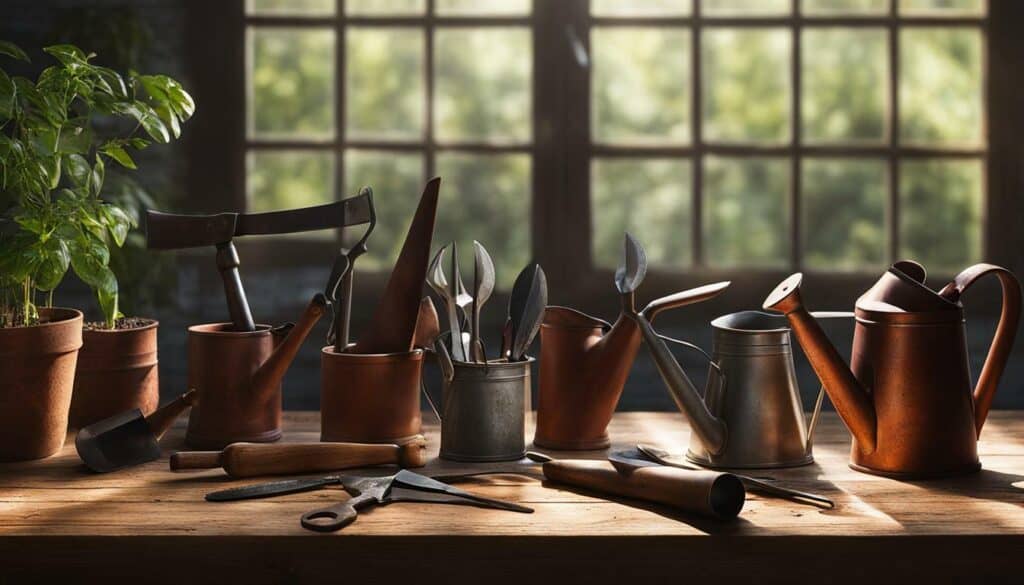
“Having the right gardening tools is like having a trusted companion in your gardening journey. They not only make your tasks easier but also contribute to the overall success of your garden.” – Gardening enthusiast
Preparing Healthy Soil for Your Garden
Lay the groundwork for a thriving garden by nurturing your soil’s health. Proper soil preparation is essential to create an environment that promotes strong root development, nutrient absorption, and overall plant growth. Here are some key steps to ensure your soil is healthy and ready for planting.
Step 1: Assess Your Soil Quality
Before you start planting, it’s important to assess the quality of your soil. This can be done by conducting a simple soil test. You can purchase a soil testing kit from a garden center or send a sample to a professional lab for analysis. The test will provide valuable information about the nutrient content, pH level, and organic matter in your soil.
Based on the results of the soil test, you can determine if any adjustments are needed. For example, if the pH level is too acidic or alkaline, you can add amendments to bring it within the optimal range for the plants you want to grow. Additionally, if the soil lacks essential nutrients, you can incorporate organic matter or fertilizers to improve its fertility.
Step 2: Add Organic Matter
One of the best ways to improve your soil’s health is by adding organic matter. This can include compost, well-rotted manure, leaf mold, or other organic materials. Organic matter improves soil structure, increases water retention, and enhances nutrient availability.
To incorporate organic matter into your soil, spread a layer of compost or well-rotted manure on the surface and gently work it into the top few inches of soil. This will help improve soil structure and fertility, creating a favorable environment for plant growth.
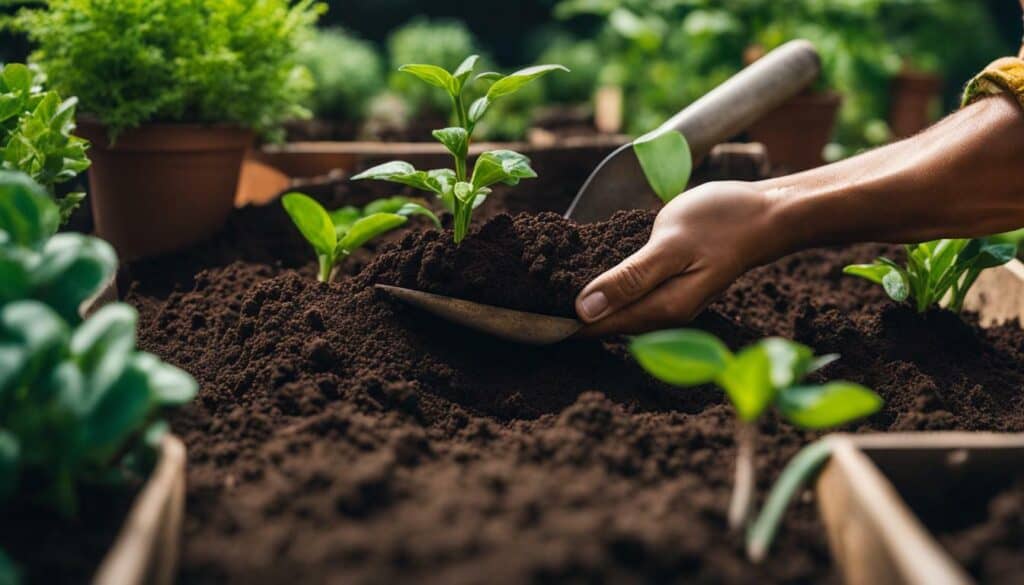
In addition to organic matter, using a low-nitrogen, slow-release fertilizer can provide your plants with essential nutrients over an extended period. This type of fertilizer releases nutrients gradually, ensuring steady growth and reducing the risk of nutrient leaching.
Before applying fertilizer, carefully read the instructions on the package to determine the appropriate amount and timing for your specific plants. Over-fertilizing can harm your plants and negatively impact soil health, so it’s important to follow the recommended guidelines.
Summary
Nurturing your soil’s health is the foundation of successful gardening. By assessing your soil quality, adding organic matter, and using a low-nitrogen, slow-release fertilizer, you can create a nutrient-rich environment that supports robust plant growth. Remember to conduct regular soil tests and make necessary adjustments to maintain optimal soil health. With healthy soil, you’ll be well on your way to a flourishing and bountiful garden.
Choosing the Right Seeds for Your Garden
Unlock the potential of your garden with carefully chosen seeds that suit your specific needs. When it comes to selecting seeds, there are a few key factors to consider. Climate, sunlight, and soil conditions are all crucial elements that will determine the success of your garden.
Start by assessing your climate. Different regions have different temperature ranges and weather patterns, so it’s important to choose seeds that are well-suited to your local climate. Consider the average frost dates in your area and select seeds that can handle the temperature fluctuations.
Sunlight is also a critical factor in seed selection. Take note of the amount of sunlight your garden receives throughout the day. Some plants thrive in full sun, while others prefer partial shade. Choose seeds that align with the sunlight conditions in your garden to ensure optimal growth.
Finally, evaluate your soil conditions. Testing your soil can provide valuable information about its pH level and nutrient content. Some plants have specific soil requirements, so it’s essential to choose seeds that can thrive in your soil type. If necessary, amend your soil with organic matter to improve its structure and fertility.
Plant Care Tips
Once you’ve selected the right seeds, it’s important to provide proper care for your plants. Follow the instructions on the seed tags for planting depth and spacing. Water your plants regularly, keeping the soil moist but not waterlogged. Weeds can compete with your plants for nutrients and water, so be sure to regularly weed your garden to keep it healthy and thriving.
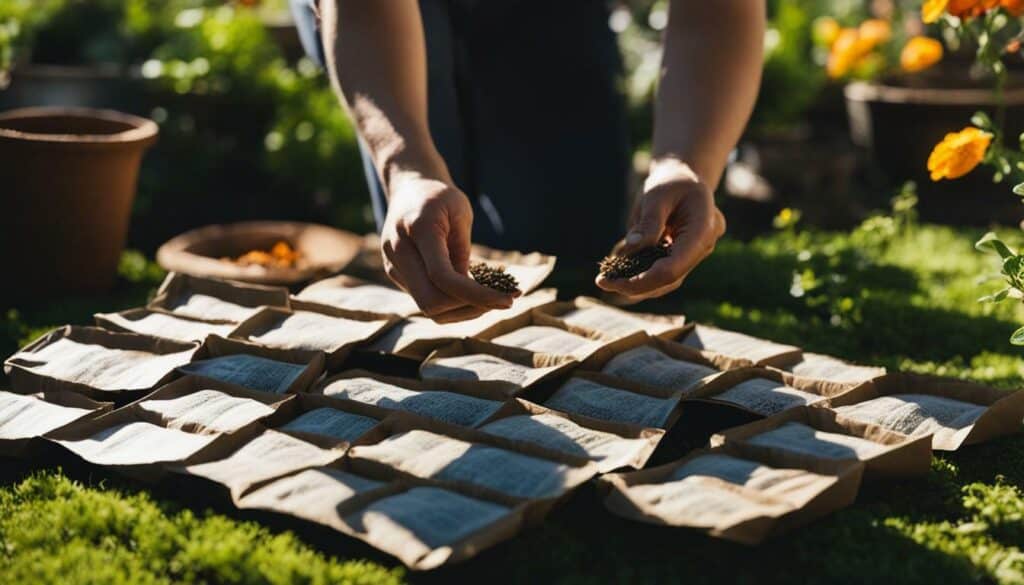
Remember, gardening is a rewarding journey that requires patience and attention. By choosing the right seeds and providing proper care, you can create a vibrant and flourishing garden that brings joy and beauty to your outdoor space.
Designing a Functional Garden Layout
Create a harmonious and inviting garden space by carefully planning its layout. A well-designed garden layout not only enhances the beauty of your outdoor space but also creates a functional area that suits your needs and preferences. Whether you have a small balcony or a spacious backyard, here are some landscaping ideas to help you design a garden layout that brings joy and tranquility.
1. Consider the Purpose of Your Garden
Before you start designing your garden layout, consider the purpose of your garden. Do you want it to be a peaceful retreat where you can relax and unwind? Or maybe you envision an entertainment area where you can host gatherings with friends and family? By identifying the purpose of your garden, you can create a layout that aligns with your vision.
2. Plan Plant Placement
The placement of plants is essential in creating a visually appealing garden. Consider the height, color, and texture of different plants to create a harmonious and balanced design. Grouping plants with similar light and water requirements will make maintenance easier and ensure that each plant thrives in its ideal environment.
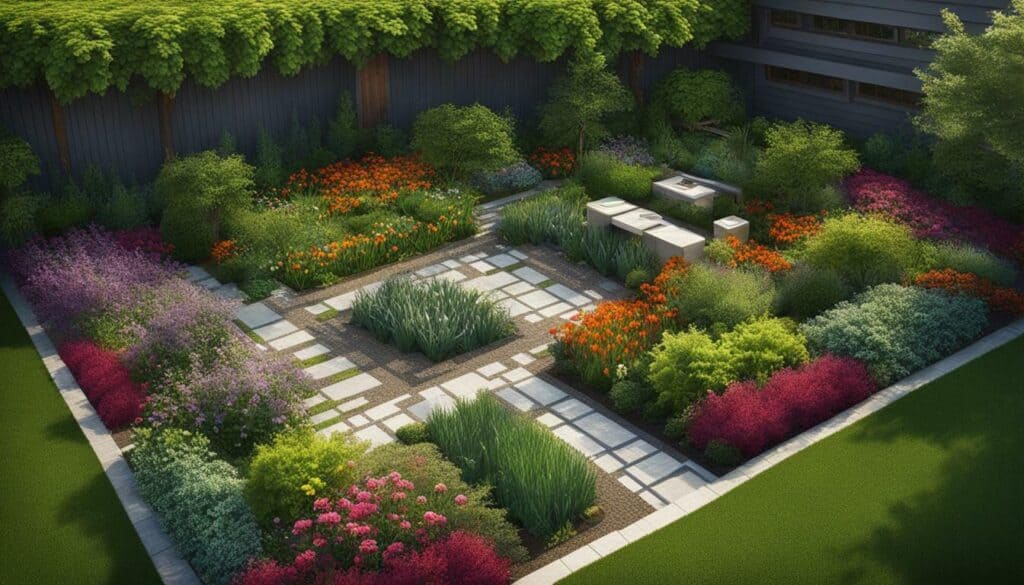
3. Create Garden Paths and Seating Areas
A well-designed garden layout includes paths that guide visitors through the space and create a sense of exploration. Use stepping stones, gravel, or pavers to create paths that lead to different areas of your garden. Incorporate seating areas such as benches, chairs, or cozy outdoor sofas where you can sit and enjoy the beauty of your garden.
4. Add Garden Structures
To add interest and functionality to your garden, consider adding structures such as pergolas, arbors, or trellises. These structures not only provide support for climbing plants but also create focal points and define different areas of your garden. They can also provide shade and privacy, enhancing the overall ambiance of your outdoor space.
By carefully planning your garden layout and incorporating these landscaping ideas, you can create a beautiful and functional garden that brings you joy and serenity. Remember to adapt these ideas to suit your specific space and preferences, and don’t be afraid to experiment and let your creativity shine.
Planting and Maintaining Your Garden
Learn the secrets of successful gardeners to keep your plants healthy and thriving. Proper planting and maintenance are crucial for the long-term success of your garden. Follow these simple plant care tips to ensure your green space flourishes.
Preparing the Soil
The first step in planting a thriving garden is to prepare the soil. Assess the quality of your soil by testing for nutrient deficiencies. You can purchase a soil testing kit from your local garden center or send a sample to a laboratory for analysis. Based on the results, you can adjust the pH level and add necessary nutrients to create a healthy environment for your plants.
Incorporating organic matter into the soil is also important for its overall health. Add compost, well-rotted manure, or other organic materials to improve its structure, drainage, and fertility. This will provide the essential nutrients that plants need to grow strong and vibrant.
Choosing the Right Seeds
When it comes to selecting seeds for your garden, it’s important to consider your specific needs and preferences. Take into account the climate, sunlight, and soil conditions in your area. Look for seeds that are well-suited to these conditions to ensure successful germination and growth. Pay attention to any special requirements or care instructions listed on the seed packets.
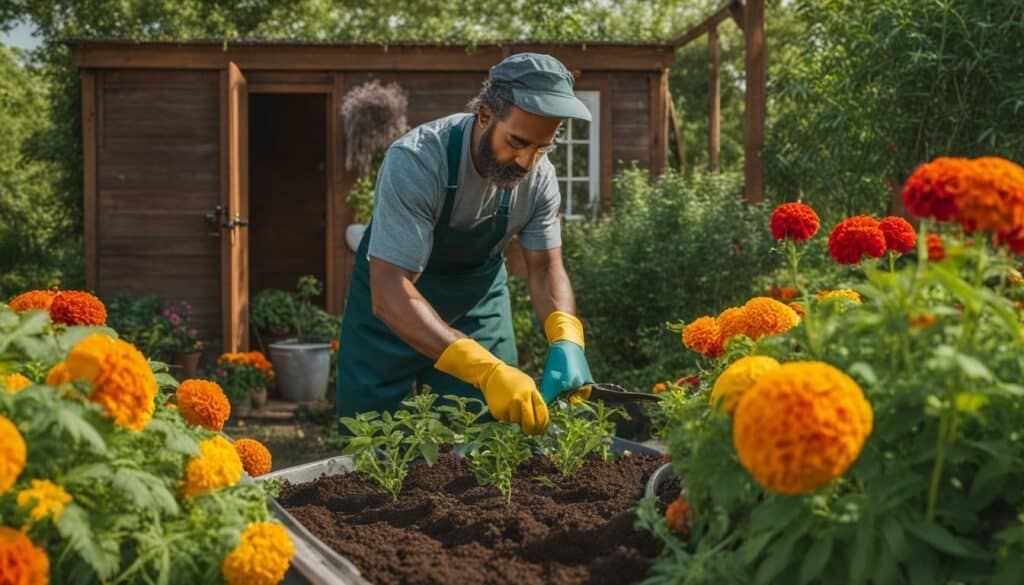
Watering and Weeding
Proper watering and regular weeding are essential for the health of your plants. Water your garden thoroughly, making sure the soil is evenly moist. The frequency and amount of watering will depend on the specific needs of your plants and the weather conditions in your area. It’s always better to water deeply and less frequently to encourage deep root growth.
Weeding is another important aspect of garden maintenance. Weeds compete with your plants for water, nutrients, and sunlight. Regularly remove weeds by hand or use natural weed control methods to keep them in check. A layer of mulch around your plants can also help suppress weed growth.
By following these plant care tips, you can ensure the health and vitality of your garden. Remember to regularly monitor your plants for any signs of pests or diseases and take appropriate action if necessary. With proper care and attention, you’ll be rewarded with a beautiful and bountiful garden.
| Plant Care Tips | – Test your soil for nutrient deficiencies – Adjust the pH level if necessary – Incorporate organic matter for improved soil health – Choose seeds suitable for your climate and conditions – Follow instructions on seed packets – Water deeply and less frequently – Regularly remove weeds – Monitor plants for pests and diseases |
|---|
The Benefits of Professional Gardening
Discover the hidden rewards that professional gardening brings to your life. Beyond the beauty and tranquility that a well-maintained garden provides, engaging in gardening activities offers numerous benefits for both your physical and mental well-being. Let’s explore some of the incredible advantages of nurturing your own green space.
- Stress Relief: Gardening has been proven to reduce stress levels and promote relaxation. Spending time outdoors, connecting with nature, and tending to plants can help lower cortisol levels and release endorphins, leading to a sense of calm and peace.
- Mood Elevation: Working in a garden not only uplifts the spirits but can also enhance your overall mood. The exposure to sunlight stimulates the production of serotonin, often referred to as the “feel-good” hormone, which can help combat anxiety and depression.
- Physical Fitness: Maintaining a garden involves physical activity, making it an excellent form of exercise. Digging, planting, weeding, and watering can contribute to improved cardiovascular health, increased flexibility, and strengthened muscles.
- Connection with Nature: Gardening provides an opportunity to reconnect with the natural world, fostering a sense of appreciation and awe for the environment. Being surrounded by plants, flowers, and wildlife can ignite a deep sense of connection, creating a more sustainable and eco-conscious mindset.
- Homegrown Delights: One of the greatest rewards of professional gardening is the ability to enjoy the fruits of your labor, quite literally. Growing your own vegetables, herbs, and fruits ensures a fresh and flavorful harvest, free from pesticides or other chemicals. There is nothing quite like the satisfaction of savoring a meal made from your own homegrown produce.
So, whether you’re an experienced gardener looking to take your skills to the next level or a beginner hoping to embark on a fulfilling journey, professional gardening offers a plethora of benefits that extend far beyond the aesthetics. Get your hands dirty, embrace the beauty of nature, and reap the countless rewards that gardening brings!
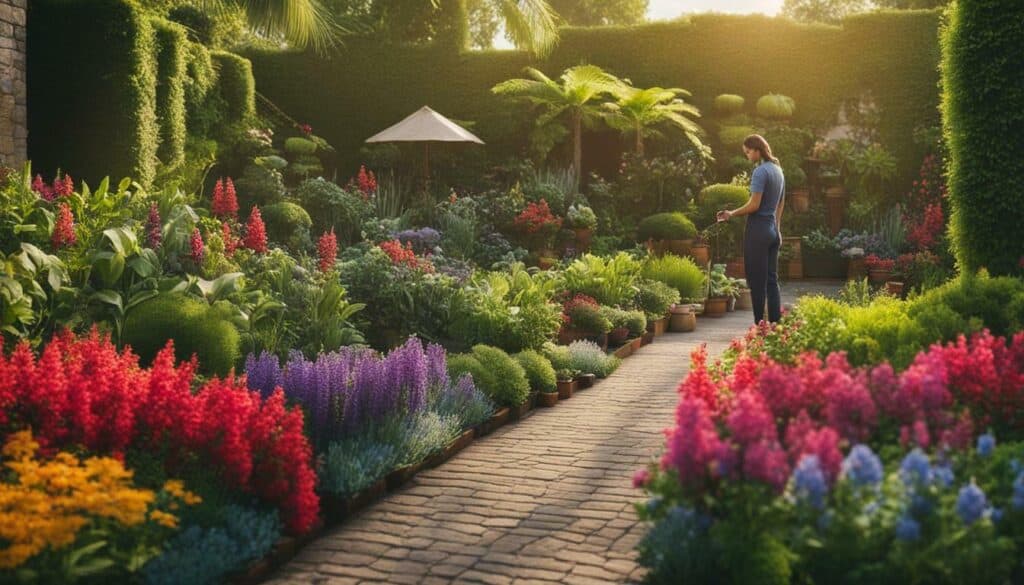
With each seed planted and every bud that blossoms, you’ll discover new joys and find solace in the simplicity of nurturing life. Gardening truly is an art that allows you to create your own beautiful sanctuary, while simultaneously nurturing your body, mind, and soul.
Embracing Nature’s Beauty
Let nature be your canvas as you embrace the beauty of a well-maintained garden. Through regular garden maintenance and professional care, you can create a captivating outdoor space that brings joy and tranquility to your everyday life.
Garden maintenance is essential to ensure your green space remains healthy, vibrant, and visually appealing. Regular tasks such as watering, weeding, and pruning help to maintain the overall health of your plants and keep them looking their best. It’s important to provide adequate water for your plants based on their specific needs, allowing the soil to dry out slightly between waterings to prevent overwatering.
Weeding is another crucial aspect of garden maintenance. Weeds compete with your plants for nutrients, water, and sunlight, and can quickly overtake your garden if left unchecked. Regularly inspect your garden for any unwelcome intruders and remove them promptly to prevent them from spreading.
Pruning is a necessary practice to control the growth and shape of your plants. It helps promote healthy growth, improve airflow, and enhance the overall appearance of your garden. Remember to use clean and sharp pruning tools to make clean cuts, minimizing the risk of disease transmission.
Professional garden care can take your gardening experience to the next level. By engaging the services of a professional gardener, you can benefit from their expertise and knowledge in plant care, pest management, and landscape design. They can provide invaluable advice and guidance tailored to your specific garden needs, helping you achieve and maintain the garden of your dreams.
Garden Maintenance Checklist:
- Water your plants regularly, ensuring they receive the appropriate amount of water based on their specific needs.
- Keep an eye out for weeds and remove them promptly to prevent them from spreading.
- Prune your plants as needed to promote healthy growth and maintain their shape.
- Engage the services of a professional gardener for expert advice and guidance on plant care, pest management, and landscape design.
Expert Tip:
“A well-maintained garden not only adds beauty to your outdoor space but also provides a peaceful sanctuary where you can connect with nature and find solace.” – Professional Gardener
Remember, a well-maintained garden is a testament to your love and dedication to nature. As you care for your plants, they will reward you with their natural beauty and the satisfaction of knowing that you have created a serene oasis right in your own backyard.
Congratulations on embarking on a journey to become a master of professional gardening. Your green thumb has the power to transform ordinary spaces into extraordinary gardens.
Mastering gardening requires proper planning, selecting the right tools and equipment, designing a functional garden layout, preparing and maintaining healthy soil, and choosing the right seeds. When planning a garden, it is important to consider the location, soil quality, and garden layout. Select a location that receives at least six hours of sunlight per day and has good drainage. Test the soil for nutrient deficiencies and adjust the pH level if necessary. Choose a garden layout that suits your space and preferences.
Essential tools for gardening include a hand trowel, pruning shears, garden gloves, watering can or hose, garden fork, rake, garden hoe, and wheelbarrow or garden cart. These tools will help you efficiently maintain your garden, ensuring its health and beauty. Selecting the right seeds depends on climate, sunlight, and soil conditions. Consider your specific needs and preferences when choosing seeds. Look for varieties that thrive in your region and provide the type of plants you desire.
Designing a functional garden layout involves considering the purpose of the garden, plant placement, garden paths, seating areas, and garden structures. Let your creativity flow as you arrange elements to create a harmonious and aesthetically pleasing space. Prepare the soil by assessing its quality, adding organic matter if necessary, and using a low-nitrogen, slow-release fertilizer. This will provide a nourishing environment for your plants to grow and flourish. Finally, follow the instructions on the seed tags and regularly water and weed your plants. Consistent care and attention will ensure the success of your garden and allow you to enjoy its beauty year-round.
Gardening has numerous benefits, both for your physical and mental well-being. It offers a form of stress relief, allowing you to unwind and connect with nature. The act of tending to your garden can elevate your mood and bring a sense of fulfillment. Additionally, watching your plants grow and produce homegrown, flavorful produce is a rewarding experience. So, embrace the beauty of nature and enjoy the many benefits that professional gardening can bring to your life.
FAQ on How to do Professional Gardening
Q: What are the essential steps for mastering gardening?
A: Mastering gardening requires proper planning, selecting the right tools and equipment, designing a functional garden layout, preparing and maintaining healthy soil, and choosing the right seeds.
Q: What should I consider when planning a garden?
A: When planning a garden, it is important to consider the location, soil quality, and garden layout. Select a location that receives at least six hours of sunlight per day and has good drainage. Test the soil for nutrient deficiencies and adjust the pH level if necessary. Choose a garden layout that suits your space and preferences.
Q: What tools do I need for gardening?
A: Essential tools for gardening include a hand trowel, pruning shears, garden gloves, watering can or hose, garden fork, rake, garden hoe, and wheelbarrow or garden cart.
Q: How do I prepare healthy soil for my garden?
A: To prepare healthy soil, assess its quality, add organic matter if necessary, and use a low-nitrogen, slow-release fertilizer.
Q: How do I choose the right seeds for my garden?
A: Selecting the right seeds depends on climate, sunlight, and soil conditions. Consider your specific needs and preferences when choosing seeds.
Q: How do I design a functional garden layout?
A: Designing a functional garden layout involves considering the purpose of the garden, plant placement, garden paths, seating areas, and garden structures.
Q: How do I plant and maintain my garden?
A: Prepare the soil, follow the instructions on the seed tags, and regularly water and weed your plants to ensure healthy growth.
Q: What are the benefits of professional gardening?
A: Gardening has numerous benefits, including stress relief, mood elevation, and the enjoyment of homegrown, flavorful produce.

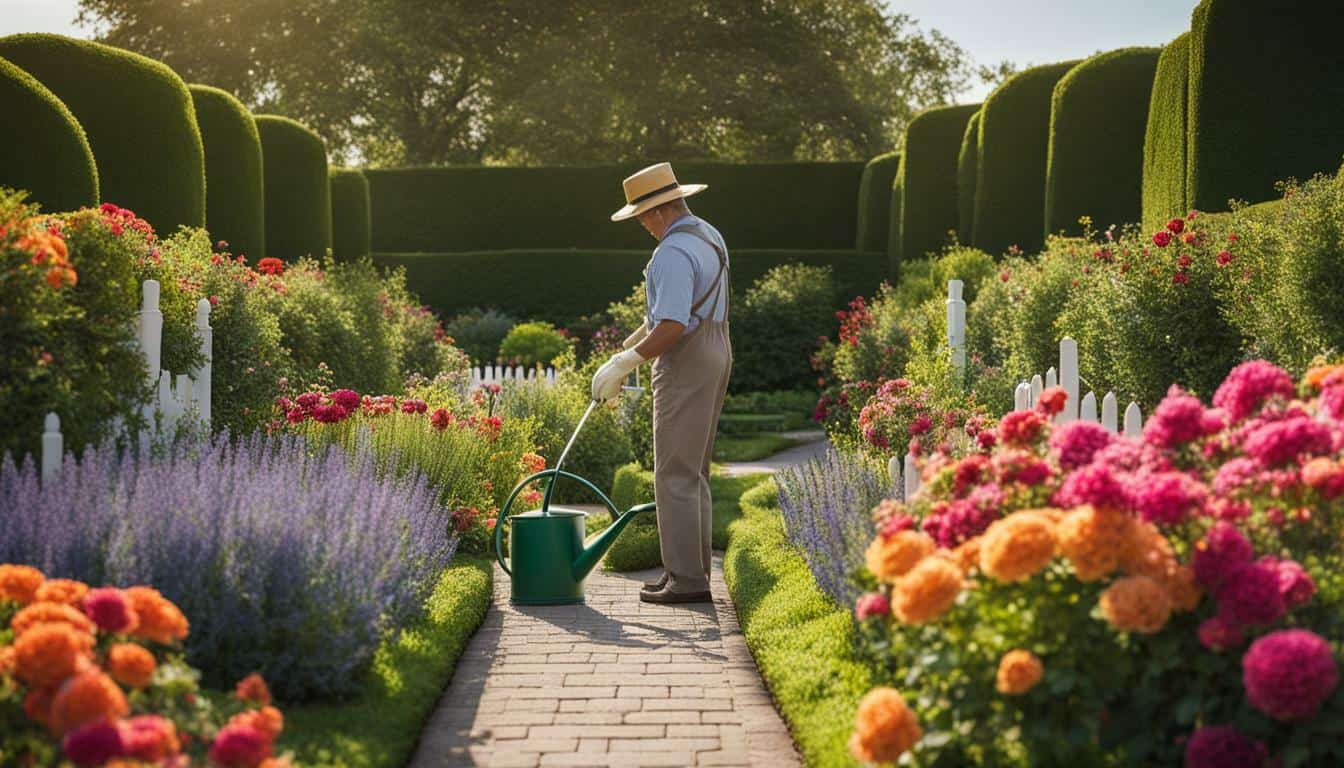



Leave a Reply